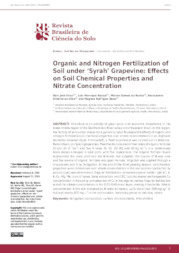Organic and nitrogen fertilization of soil under Syrah grapevine: effects on soil chemical properties and nitrate concentration.
Organic and nitrogen fertilization of soil under Syrah grapevine: effects on soil chemical properties and nitrate concentration.
Autoria: SILVA, D. J.; BASSOI, L. H.; ROCHA, M. G. da; SILVA, A. O. da; DEON, M. D.
Resumo: Viticulture is an activity of great social and economic importance in the lower-middle region of the São Francisco River valley in northeastern Brazil. In this region, the fertility of soils under vineyards is generally poor. To assess the effects of organic and nitrogen fertilization on chemical properties and nitrate concentrations in an Argissolo Vermelho-Amarelo (Typic Plinthustalf), a field experiment was carried out in Petrolina, Pernambuco, on Syrah grapevines. Treatments consisted of two rates of organic fertilizer (0 and 30 m3 ha-1) and five N rates (0, 10, 20, 40, and 80 kg ha-1), in a randomized block design arranged in split plots, with five replications. The organic fertilizer levels represented the main plots and the N levels, the subplots. The source of N was urea and the source of organic fertilizer was goat manure. Irrigation was applied through a drip system and N by fertigation. At the end of the third growing season, soil chemical properties were determined and nitrate concentration in the soil solution (extracted by porous cups) was determined. Organic fertilization increased organic matter, pH, EC, P, K, Ca, Mg, Mn, sum of bases, base saturation, and CEC, but decreased exchangeable Cu concentration in the soil by complexation of Cu in the organic matter. Organic fertilization raised the nitrate concentration in the 0.20-0.40 m soil layer, making it leachable. Nitrate concentration in the soil increased as N rates increased, up to more than 300 mg kg-1 in soil and nearly 800 mg L-1 in the soil solution, becoming prone to leaching losses.
Ano de publicação: 2016
Tipo de publicação: Artigo de periódico
Unidade: Embrapa Semiárido
Palavras-chave: Adubação orgânica, Carbono, Fertirrigação, Grapes, Micronutrientes, Micronutrients, Solo, Solução do Solo, Uva, Vitis Vinifera, carbon, fertigation, soil solution
Observações
1 - Por padrão são exibidas publicações dos últimos 20 anos. Para encontrar publicações mais antigas, configure o filtro ano de publicação, colocando o ano a partir do qual você deseja encontrar publicações. O filtro está na coluna da esquerda na busca acima.
2 - Para ler algumas publicações da Embrapa (apenas as que estão em formato ePub), é necessário ter, no celular ou computador, um desses softwares gratuitos. Sistemas Android: Google Play Livros; IOS: iBooks; Windows e Linux: software Calibre.
Acesse outras publicações
Acesse a Base de Dados da Pesquisa Agropecuária (BDPA) para consultar o acervo completo das bibliotecas da Embrapa.

